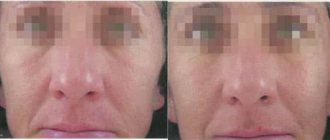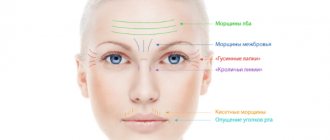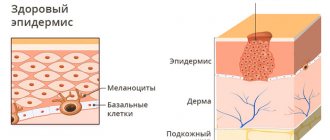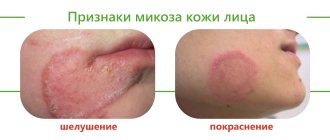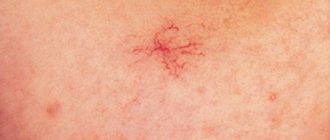Causes of dry and sagging skin
Skin laxity is a loss of firmness and elasticity in the skin, and its appearance is not always associated with natural aging.
Causes of sagging skin:
- Poor nutrition – frequent adherence to diets with strict restrictions, or, on the contrary, abuse of sweets and light carbohydrates, leading to the process of glycation in the skin.
- Disturbance in sleep patterns - lack of sleep leads to disturbances in circadian rhythms and lack of full recovery of both the entire body and the skin in particular. It is at night that most of the synthetic processes take place, i.e. cellular renewal and formation of young chains of collagen, elastin and hyaluronic acid.
- Poor environment, stress, smoking lead to the destruction of vitamin C and the skin’s protective system. The aggression of free radicals leads to the destruction of collagen fibers, and the lack of vitamin C slows down the formation of new ones.
- Passion for tanning - even active tanning 2 times a year during vacation. Exposure to ultraviolet rays reduces the activity of fibroblasts, they synthesize less collagen and hyaluronic acid, and more metalloproteinase enzymes are produced that destroy their own collagen.
- Cosmetics: incorrectly selected, poor quality, lack of regular and properly selected care - violates skin barriers, making it more sensitive and susceptible to other negative factors.
The presence of dry and sagging skin indicates a combination of several provoking factors, when premature aging of the skin occurs against the background of impaired barrier function.
Numbness of the face
Stroke
Diabetes
37601 March 16
IMPORTANT!
The information in this section cannot be used for self-diagnosis and self-treatment.
In case of pain or other exacerbation of the disease, diagnostic tests should be prescribed only by the attending physician. To make a diagnosis and properly prescribe treatment, you should contact your doctor. Numbness of the face: causes of occurrence, what diseases it occurs with, diagnosis and treatment methods.
Definition
Numbness of the face occurs when the sensitivity of skin and muscle receptors to various impulses is impaired. This symptom may develop gradually or appear suddenly. Loss of facial sensitivity is described as burning, tingling, sometimes pain, and in some cases as a complete absence of sensation. When the face is numb, the color of the skin over the affected area may change in the form of pallor or redness.
In severe cases, sensory impairment is accompanied by a decrease in the motor function of the facial muscles.
Types of facial numbness
Any external influence, be it heat or cold, light touch or strong pressure, leads to activation of skin receptors and muscle structures. Each receptor is associated with a specific type of nerve fiber that transmits a specific type of sensitivity (sensation of pressure on the skin, vibration, stretching of the skin, and temperature sensitivity). An impulse is generated in the receptor, which is sent through nerve fibers at high speed to the nerve ganglia, which are a collection of sensory neurons. This is where primary information processing occurs to activate vital reflexes. Subsequently, the impulse goes to the brain, where it is processed in special nerve centers, and the person feels pain, pressure, vibration, etc. Thus, we can talk about the following types of sensitivity disorders:
- Violation of surface sensitivity
occurs when receptors (temperature, tactile, pain, etc.) and nerve fibers of the facial skin are damaged. - Violation of deep sensitivity
occurs when the receptors and nerve fibers of the facial muscles are damaged. - Violation of complex types of sensitivity
. A similar type of disorder occurs when the cerebral cortex is damaged. There is no recognition of two different stimuli that simultaneously affect the skin, or the person cannot determine the location of the touch.
Possible causes of facial numbness
In many cases, numbness in different parts of the face is short-term, passing within a few minutes.
Such episodes can occur when the head is positioned in an awkward position, for example during sleep.
This occurs due to compression of the nerve fibers and a temporary disruption of impulse conduction. There is a burning and tingling sensation in the affected area. Partial loss of sensitivity is observed with prolonged exposure to the cold due to vasospasm. After gradual warming of the skin, sensitivity is restored.
However, facial numbness can be a symptom of a serious medical condition.
Acute cerebrovascular accident, or stroke
– a common cause of sudden numbness of the face in combination with a violation of facial activity. Hemorrhage or blockage of brain vessels by a thrombus (blood clot) occurs, acute oxygen deficiency and damage to neurons with disruption of their functions develops. Symptoms develop unexpectedly, sometimes accompanied by headache.
The main signs of a stroke are: numbness of the face and limbs on one or both sides, sudden weakness, speech impairment (inability to clearly pronounce words), drooping of the corner / corners of the mouth, uncoordination of movements.
If these symptoms appear, you should immediately seek medical help. A cerebral aneurysm
can cause numbness in the face due to compression of nerve fibers and sensitive centers of the brain. It usually develops gradually; at the onset of the disease, symptoms may be completely absent. Numbness first affects one area of the face (for example, perioral), and with further growth of the aneurysm, the affected area gradually expands. Sensations may also change: from tingling, burning at first - to a complete absence of sensations later.
There is a danger of rupture of a cerebral aneurysm; in this case, the symptoms are similar to those of a stroke and appear quickly.
Trigeminal neuritis
often accompanies inflammatory diseases of the oral cavity (caries, periodontitis), ear (otitis), paranasal sinuses (sinusitis, frontal sinusitis, ethmoiditis), parotid glands (mumps). The branches of the trigeminal nerve are irritated, which can lead to numbness in the corresponding areas of the face.
Impaired sensitivity with increased tone of the masticatory muscles
occurs due to compression of the branches of the trigeminal nerve by muscle fibers. Hypertonicity of the masticatory muscles is characteristic of damage to the temporomandibular joint due to arthritis and arthrosis, incorrectly selected braces, and certain diseases of the pharynx, for example, peritonsillar abscess.
Diabetes
– with this disease, the process of utilization of glucose from the blood is disrupted, which leads to damage to the vascular wall and disruption of the nutrition of nerve bundles. In the absence of maintenance therapy, tingling and partial loss of sensitivity in areas where the blood supply is impaired may occur.
Numbness of the face in multiple sclerosis
occurs due to demyelination (disappearance of the outer sheath) of the nerve fibers of the trigeminal nerve. Numbness is often preceded by severe pain not only in the face, but also in the limbs.
Tumors of the brain and its membranes
lead to impaired sensitivity in the facial area due to compression of the neurovascular bundles or tumor growth in them.
Which doctors should I contact if I have facial numbness?
If your face becomes numb, you should consult a neurologist or therapist. In some cases, consultation with an otolaryngologist, endocrinologist, or dentist may be required.
Diagnosis and examinations for facial numbness
Depending on the suspected cause of facial numbness, the following laboratory and instrumental studies may be required:
- clinical blood test;
What happens inside the skin
Information for specialists
The appearance of sagging skin is associated with disturbances in the structure of the dermal layer of the skin:
- Changes in the structure and functioning of fibroblasts - they become more rigid and flat, their synthetic activity decreases, which leads to a decrease in the viscoelastic properties of collagen.
- An insufficient amount of collagen and a violation of its structure leads to impaired contact between fibers and fibroblasts, which for normal functioning must be in a stretched, spindle-shaped state.
- This is how a “vicious circle” arises : lack of collagen synthesis <=> dysfunction of fibroblasts.
Such changes most affect the fibroblasts of the papillary dermis, which primarily affects the normal structure of the papilla of the epidermal-dermal junction.
There is a smoothing of the papillae, which manifests itself in the initial stages as sagging skin. There is a feeling of insufficient tension and elasticity, subsequently ptosis and wrinkles form .
Causes of dry facial skin
Dry skin is characterized by tightness, flaking, dull tone, regular irritation and a finely porous structure. These features are genetic and associated with insufficient production of sebum and low activity of the sebaceous glands.
This is why dry skin has a very thin hydrolipid barrier. It consists of water, fatty acids and in normal condition protects the skin from negative factors. But in the dry type, this barrier functions poorly, which leads to negative consequences: disruption of the lipid and water barrier, weak functioning of the sweat and sebaceous glands, and a slightly acidic pH reaction (acid-base state).
Despite the fact that your skin type is given at birth, you can choose the right skin care products and get rid of the negative features inherent in dry skin.
How to deal with sagging and dry skin
Seeing dry, flabby skin with reduced turgor, cosmetologists often recommend a biorevitalization - i.e. injection of hyaluronic acid into the dermal layer of the skin. Which, by the way, comes out very quickly (from 2 to 5 days).
There is no need to rush into replacement therapy because:
- This does not solve the problem of dry skin and impaired barrier function.
- Why introduce a foreign product when the skin itself is able to compensate for the resulting deficiency by eliminating the causes of its formation.
Features of dry facial skin
Dry skin is often confused with dehydrated skin. However, these concepts have fundamental differences. Dehydrated skin looks loose and is characterized by deep and long wrinkles. She suffers from a lack of moisture due to changes in the intercellular matrix of the dermis. But this problem can occur with both normal and oily skin.
Dry skin has impaired barrier properties, so it lacks not only moisture, but also fatty lubrication. In addition, dehydration can be eliminated, while skin type is determined at the genetic level.
Although in both cases the skin feels a lack of water, the methods of moisturizing will be radically different. This is due to the level of external influences and structural changes that led to the shortage.
Correction plan for dry skin with sagging
Eliminate exposure to all provoking factors
Normalization of nutrition, intake of vitamins and active supplements, normalization of sleep and rest patterns.
Protects skin from UV and blue light rays
Flabby skin, atonicity, dyspigmentation of the facial skin, eye fatigue and general fatigue, problems with falling asleep - these are all manifestations of the negative effects of blue light. Its sources: computer, tablet, smartphones and fluorescent lamps.
According to research, blue light is 15 times more dangerous than the rest of the visible light range. Causes powerful oxidative stress, provokes degradation of collagen fibers, the appearance of age spots, dryness and increased sensitivity of the skin.
CBD "Blue Light" face cream SPF 30 DermaQuest is a complete daytime skin care for moisturizing, protecting and preventing sagging skin.
- Contains a physical photo filter – Zinc Oxide – a mineral screen from all types of UV rays;
- Moisturizes, nourishes and restores the skin - contains Shea butter and Aloe extract ;
- Absorbs well, can be used as a base for makeup - a complete day cream;
- Contains BlueLight filter - InfraGard - blue light protection;
- Vitamin C – prevention of pigmentation and premature aging;
- A unique ingredient - cannabidiol - heals the skin, normalizes the functioning of skin cells;
Restore skin barrier function
First of all, it is necessary to recommend not rejuvenating procedures, but those that restore the integrity of skin barriers - the lipid substance of the epidermis to prevent dehydration and restore the protective function of the skin.
Use a cream that contains representatives of 2-3 main groups:
- Hydrants are substances that attract and retain water molecules in the skin: urea, lactic acid, ceramides, hyaluronic acid, glycerin.
- Emollients are substances that create a protective film on the surface of the skin (it is they that determine the density of the cream) - these are vegetable and mineral oils, fats, waxes, dimethicone.
- Ingredients that restore hydration of skin cells by increasing aquaporins - cell channels through which moisture penetrates inside. These are AquaCell, Aquasens, Diffuporin.
CBD "Blue Light" face moisturizer DermaQuest - a powerful face moisturizer with Cannabidiol (CBD) and Blue Light protection - actively moisturizes dehydrated skin, revitalizes, and conducts moisture into the cells. Instantly gives peace and comfort. 80% natural composition.
It contains a unique AquaCell complex - a double blow against dehydrated skin: it supplies moisture inside the cell and retains it in the deep layers of the skin. Smoothes wrinkles within 2 hours of application, maintaining hydration levels for 24 hours.
Signs of dry facial skin
One of the main indicators of dry skin is the absence of oily shine. Try going without makeup or skincare products for a few hours, and then pat your skin dry with a tissue. If there is no oily shine, most likely you have a dry type. There are other signs that point to it:
- feeling of tightness,
- high sensitivity,
- severe dryness in winter,
- invisible pores
- no rashes, pimples,
- frequent peeling
- early signs of aging (wrinkles).

